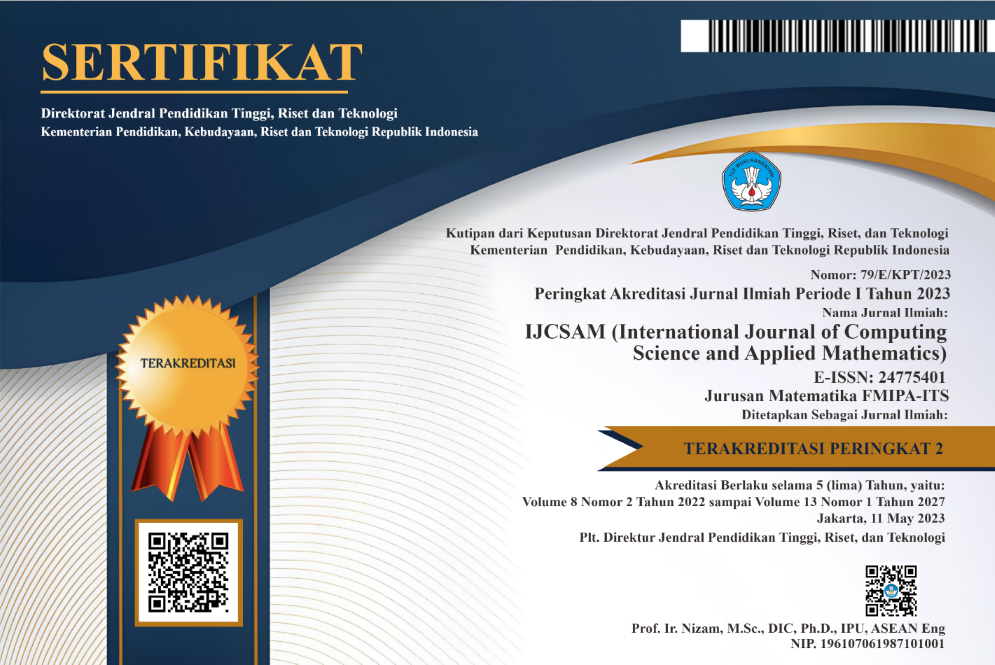Evaluating the Fitting Performance of AGARCH(1,1), NAGARCH(1,1), and VGARCH(1,1) Models
Abstract
Keywords
Full Text:
PDFReferences
L. K. Sari, N. A. Achsani, and B. Sartono, “The volatility transmission of main global stock’s return to indonesia,” Buletin Ekonomi Moneter dan Perbankan, vol. 20, no. 2, pp. 229–256, 2017.
B. M. Blau and R. J. Whitby, “Range-based volatility, expected stock returns, and the low volatility anomaly,” Plos one, vol. 12, no. 11, p. e0188517, 2017.
D. d. Almeida and L. K. Hotta, “The leverage effect and the asymmetry of the error distribution in garch-based models: The case of brazilian market related series,” Pesquisa Operacional, vol. 34, pp. 237–250, 2014.
D. d. Almeida and L. K. Hotta, “The leverage effect and the asymmetry of the error distribution in garch-based models: The case of brazilian market related series,” Pesquisa Operacional, vol. 34, pp. 237–250, 2014.
R. F. Engle and V. K. Ng, “Measuring and testing the impact of news on volatility,” The journal of finance, vol. 48, no. 5, pp. 1749–1778, 1993.
A. Azzalini, “Skew normal distribution,” International encyclopedia of statistical science, vol. 19, pp. 1342–1344, 2011.
R. B. Arellano-Valle, H. W. Gomez, and F. A. Quintana, “A new class of skew-normal distributions,” Communications in statistics-Theory and Methods, vol. 33, no. 7, pp. 1465–1480, 2004.
D. B. Nugroho and B. Susanto, “Volatility modeling for idr exchange rate through aparch model with student-t distribution,” in AIP Conference Proceedings, vol. 1868, no. 1. AIP Publishing, 2017.
D. B. Nugroho, B. Susanto, K. N. P. Prasetia, and R. Rorimpandey, “Modeling of returns volatility using garch(1,1) model under tukey transformations,” Jurnal Akuntansi dan Keuangan, vol. 21, no. 1, pp. 12–20, 2019.
M. W. Burkett and W. T. Scherer, “A fundamental misunderstanding of risk: The bias associated with the annualized calculation of standard deviation,” Cogent Economics & Finance, vol. 8, no. 1, p. 1857005, 2020.
Student, “The probable error of a mean,” Biometrika, vol. 6, no. 1, pp. 1–25, 1908.
M. Ahsanullah, B. G. Kibria, and M. Shakil, Normal and student’s t distributions and their applications. Springer, 2014, vol. 4.
M. Blangiardo and M. Cameletti, Spatial and spatio-temporal Bayesian models with R-INLA. John Wiley & Sons, 2015.
L. S. Lasdon, R. L. Fox, and M. W. Ratner, “Nonlinear optimization using the generalized reduced gradient method,” Revue franc¸aise d’automatique, informatique, recherche operationnelle. ´Recherche operationnelle ´ , vol. 8, no. V3, pp. 73–103, 1974.
L. S. Lasdon, A. D. Waren, A. Jain, and M. Ratner, “Design and testing of a generalized reduced gradient code for nonlinear programming,” ACM Transactions on Mathematical Software (TOMS), vol. 4, no. 1,pp. 34–50, 1978.
D. B. Nugroho, B. Susanto, K. N. P. Prasetia, and R. Rorimpandey, “Modeling of returns volatility using garch (1, 1) model under tukey transformations,” Jurnal Akuntansi dan Keuangan, vol. 21, no. 1, pp. 12–20, 2019.
S. G. Powell and R. J. Batt, Modeling for insight: a master class for business analysts. John Wiley & Sons, 2011.
Y. F. Atchade and J. S. Rosenthal, “On adaptive markov chain monte carlo algorithms,” Bernoulli, vol. 11, no. 5, pp. 815–828, 2005.
M. Cullan, S. Lidgard, and B. Sterner, “Controlling the error probabilities of model selection information criteria using bootstrapping,” Journal of Applied Statistics, vol. 47, no. 13-15, pp. 2565–2581, 2020.
M. Snipes and D. C. Taylor, “Model selection and akaike information criteria: An example from wine ratings and prices,” Wine Economics and Policy, vol. 3, no. 1, pp. 3–9, 2014.
E. Paparoditis and D. N. Politis, “The asymptotic size and power of the augmented dickey–fuller test for a unit root,” Econometric Reviews, vol. 37, no. 9, pp. 955–973, 2018.
F. Ahmad and R. A. Khan, “A power comparison of various normality tests,” Pakistan Journal of Statistics and Operation Research, pp. 331–345, 2015.
H. Le, U. Pham, P. Nguyen, and T. B. Pham, “Improvement on monte carlo estimation of hpd intervals,” Communications in StatisticsSimulation and Computation, vol. 49, no. 8, pp. 2164–2180, 2020.
D. Ardia and L. F. Hoogerheide, “Bayesian estimation of the garch (1,1) model with student-t innovations,” The R Journal, vol. 2, no. 2, pp. 41–47, 2010.
P. J. Deschamps, “A flexible prior distribution for markov switching autoregressions with student-t errors,” Journal of Econometrics, vol. 133, no. 1, pp. 153–190, 2006.
DOI: http://dx.doi.org/10.12962%2Fj24775401.v9i2.15921
Refbacks
- There are currently no refbacks.
View My Stats

International Journal of Computing Science and Applied Mathematics by Pusat Publikasi Ilmiah LPPM, Institut Teknologi Sepuluh Nopember is licensed under a Creative Commons Attribution-ShareAlike 4.0 International License.
Based on a work at https://iptek.its.ac.id/index.php/ijcsam.






